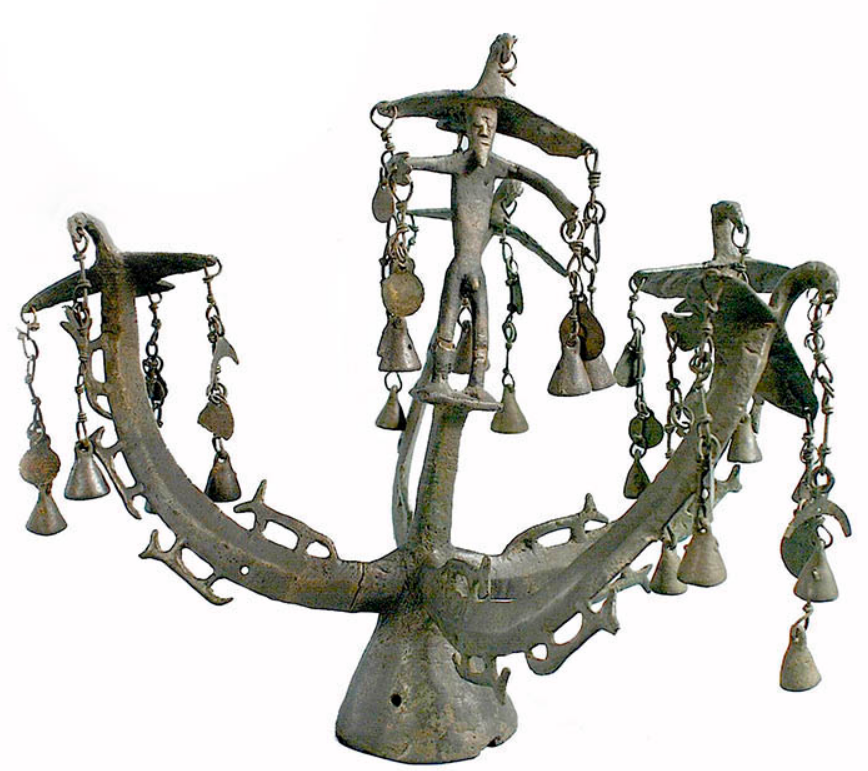“The only gods they try to appease are Hestia, who is their most important divinity, Zeus, and Earth,” whom they consider to be the wife of Zeus; after these, they worship Apollo, Ourania Aphrodite, Herakles, and Ares. While these are the traditional gods of all the Scythians, the Royal Scythians also sacrifice to Poseidon. In the Scythian language, Hestia is called Tabiti; Zeus, Papaiosa (and most correctly so, in my opinion); Earth is called Api; Apollo, Goitosyros; Ourania Aphrodite, Argimpasa; and Poseidon, Thagimasadas“. (Herodotus, 4. 59)
Doctor of History Dmitriy Raevskiy (1941-2004) who specialized in Scythian archaeology wrote: “The Scythian Zeus-Papaios was indeed worshipped as the progenitor of the dynasty of the Scythian kings. Herodotus perceived in it a similarity with the word papa (father), which was used in the Greek language as well, and noted that this name fully corresponded to the function of that deity in Scythian mythology, where he indeed played the role of the progenitor of the other deities and of the entire Scythian ethnos. Among the so-called Scythian standards, it is interesting to note two practically identical specimens that had been found in different regions of Scythia. The standard found near the present-day town of Dnipro, from the Lysa Gora barrow, is better preserved (title image). This is a bronze object which is attached to a vertical wooden staff by means of an insert. Its central element is a naked male figure placed on a small pedestal immediately above the insert, probably the image of some Scythian deity. Four little horns twisted to point outward start from this “pedestal” to form a cross. Figures of birds with spread wings are fixed on the tips of these horns (as well as above the head of the deity). Chains with little bells are hanging from the wings and the beaks of the birds, as well as from the hands of the deity. In the middle part of each of the horns, one can see sculpted images of some animals (wolves?), which seem to be moving from the center in the four directions. As a whole, the composition correlates well with the cosmological model: the male figure personifies the center of the Universe, i.e. the axismimdi/ the zoomorphic symbols serve to oppose the upper, celestial world (the birds) to the terrestrial one (the wolves); parallel with this, their repetition four times on the horns pointing to the four directions, attributes a horizontal structure to space. Opinions among Scythologists vary on the interpretation of the deity depicted on the standard. Ensuing from the circumstance that his figure is slightly raised above the basis of the horns and is practically at the same level with the birds, he could be identified with the celestial deity Papaios. Conversely, assuming that this deity served as an element linking the level of the Earth and that of the sky. being at the same time in the center of the terrestrial world, then this was more likely to be the personification of this world, i.e. the god and the first man Targitaos. The image lacks reliable diagnostic features that would give more weight to one interpretation compared to the other.”
The unique pole top dating to ca. IVth century B.C. was accidentally found near the city of Nikopol in the Dnipro oblast of Ukraine. Famous archaeologist Vikenty Khvoyka purchased it at a local market in 1896. The pole top represents the Scythian World Tree that had four branches signifying four parts of the world. In the center of the tree – is the figure of the supreme Scythian god Papiosa. On his head sits a sacral bird. Different animals and birds on four branches of the tree are most likely the spirits-helpers. National Muzeum of History of Ukraine.
“Papaiosa” is translated like “father” from the Scythian language, that is why Herodotus expressed his consent with the Scythian name of the god. It is worth mentioning that to a Ukrainian ear, the name of the chief male god of the Scythians sounds very similar to “Papa Usiogo” which translates as “Father of Everything” and it hardly can be a coincidence. The “Cradle of Civilizations” hardcover book explains why. “Royal Scythia, Greece, Kyiv Rus” book has little-known facts about Scythian Culture in the area of present-day Ukriane.
Read the description of the Pole-Top by the National Museum of the History of Ukraine.
